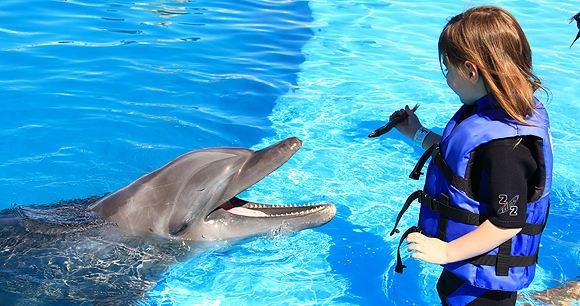
Swim-with Attractions
The many swim-with captive dolphin attractions around the world are very popular and lucrative for the tourism industry. Although it may seem like a fun and harmless way to spend an afternoon while on vacation, it is far from harmless for the dolphin and could be dangerous to humans.
In addition to being captive—possibly having been taken from the wild—and being subject to a multitude of stressors, swim-with dolphins are denied choice and are forced to repeatedly interact with human strangers.
Dolphin swim-with encounters can also be dangerous, since the animals may become stressed and can injure visitors. The dolphins in these attractions are still very much wild animals. Dolphins can also carry potentially dangerous diseases that have been transmitted to humans.
As dolphinariums expand in various regions, cetaceans are taken from their natural habitat to be confined in enclosures for human entertainment. Young females, vital members of the community, are the most sought after because they are less aggressive than males and form the basis for breeding programs. Such attractions are flourishing in vacation resorts in regions such as the Caribbean and the South Pacific, where facilities may be poorly maintained with little regulation or oversight.
In 1994 the US National Marine Fisheries Service (NMFS), the agency responsible for implementing and enforcing the Marine Mammal Protection Act, published a report on swim-with dolphin encounters. It found that “[D]olphins are large, powerful animals that can inflict serious harm on people. NMFS has injury reports on file that illustrate the potential risks to swimmers and dolphins in [swim-with] programs are real, and should not be overlooked or disregarded.” The report concluded that to ensure the safety of dolphins and swimmers, swim-with dolphin encounters should be strictly controlled.
Dolphin Assisted Therapy
Dolphin Assisted Therapy (DAT) is a type of swim-with dolphin encounter that is used for people suffering from mental or physical disorders as a form of treatment. DAT proponents foster an unproven belief that there are unique motivational and health benefits to touching and being close to a dolphin, although studies show that such claims are without scientific merit. There is no evidence that DAT is any more therapeutic than other forms of animal-assisted therapy, which are far less expensive for patients and less harmful to animal welfare (as domesticated species are used).
DAT sessions can cost thousands of dollars. Many parents of disabled children seek multiple sessions, in an understandable desire to help their loved one at any cost. As a result, DAT facilities are cropping up in many countries, with DAT often used to justify construction of new dolphin facilities, giving an “altruistic” cover to a money-making scheme. This industry thrives on the vulnerability of its patients, and both patients and dolphins are exploited for profit.
Myths and Facts about Interacting with Whales and Dolphins
Myth:
All whales and dolphins (collectively, “cetaceans”) want to be with us as much as we want to be with them.
Fact:
Cetaceans are wild animals, wholly aquatic, with no particular interest in or connection to terrestrial mammals, including humans. Not harming them sometimes means leaving them alone. Interactions with cetaceans in the wild should be minimized and cetaceans do not belong in captivity at all.
Myth:
Swimming with whales and dolphins in the wild is harmless.
Fact:
When swimmers enter the water to try to swim with free-ranging cetaceans, this is an added level of invasion of their living space—from two dimensions (on a boat at the water’s surface) to three (in the water with them). The most common activity free-ranging cetaceans are pursuing when swimmers try to swim with them is resting (otherwise human swimmers wouldn’t be able to keep up with them). So swimmers are essentially disturbing their sleep. This can have long-term negative impacts. The only time it is appropriate to swim with whales and dolphins in the wild is when they approach people. If, conversely, people approach them, then the interaction is probably disturbing them.
Myth:
Swimming with captive dolphins is a great idea—a “bucket list” activity!
Fact:
In nature, whales and dolphins tend to have complex and stable social bonds—strangers are very rarely encountered. Captive whales and dolphins in normal performance exhibits have relatively long-term, stable bonds with their trainers. However, dolphins in swim-with attractions must interact with many strangers every day. This is not natural and adds additional stress to an already stressful situation.